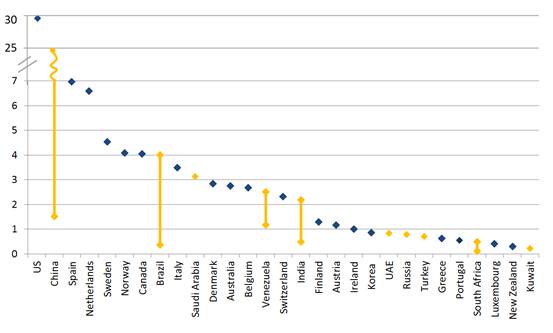This is a joint post with Julie Walz.
As we approach the Fourth High Level Conference on Aid Effectiveness in Busan, South Korea, the topic of emerging donors looms large. While some policymakers hope the BRICs (Brazil, Russia, India and China) will play a larger role, others warn they lack a collective agenda and do not have enough influence in a space dominated by members of the OECD-DAC.
In a new working paper for the Center for Global Development, we survey the literature on emerging donors and the role they play in delivering foreign assistance. We find a wide range of estimates regarding total aid flows from the so-called new donors, from $11 billion to $41.7 billion, meaning between 8 and 31 percent of global gross ODA. If the upper estimates are to be believed, China, Brazil, and Saudi Arabia give more ODA than half of the DAC donors. Four non-DAC donors (Venezuela, Saudi Arabia, UAE, and China) reach the oft-mentioned target of 0.7% of GNI. Lower estimates are less dramatic, yet still represent a remarkable (and growing) contribution. 
Despite popular terminology, most of the so-called emerging donors are not new; some have been running aid programs for as long as traditional DAC donors. There are also fairly big differences amongst these so-called newcomers. Zimmermann and Smith (2011) place non-traditional donors into three separate groups, which might also represent three models of aid delivery. The DAC Model is primarily made up of countries that are members of the OECD or the European Union, but not the DAC itself- these include the Czech Republic, Estonia, Hungary, Iceland, Israel, Poland, the Slovak Republic, Slovenia, and Turkey and Russia. These countries base their emerging aid programs on the DAC and most likely to officially join DAC, following the path of South Korea. The Arab Model includes some of the most established and generous aid programs in the world. There is a high level of coordination between Arab donors and their aid tends to predominately flow to other Arab countries. This aid is openly influenced by social solidarity and religious ties. The Southern Model includes many emerging economies- Brazil, China, India, and South Africa, among others.
The DAC is actively attempting to engage non-DAC donors; it has invited representatives from Southern countries to participate in Senior Level meetings and is initiating dialogue through programs such as the China-DAC Study Group. The Working Party on Aid Effectiveness and Task Team on South-South Co-operationhave also held meetings leading up to Busan. The problem is that efforts to engage emerging donors are mostly being launched under the OECD-DAC umbrella. Given that emerging donors do not want to conform to the DAC model, we conclude that the international aid community needs a more independent forum for these discussions, one that is not tied to a largely Western model of doing business. The DAC could be a donor caucus within this independent, global body, not the other way around. A more independent platform would likely allow equal space for the DAC, the Arab, and the Southern models to coexist. The United Nations Development Cooperation Forum (DCF) has the potential to become this independent body, although it is still a relatively new entity. The International Aid Transparency Initiative (IATI) is also a more neutral platform with the goal of improving transparency and aid reporting. If it can position itself successfully as a truly independent entity, IATI has the potential to engage non-DAC donors, and to improve our understanding of the changing nature of foreign assistance.